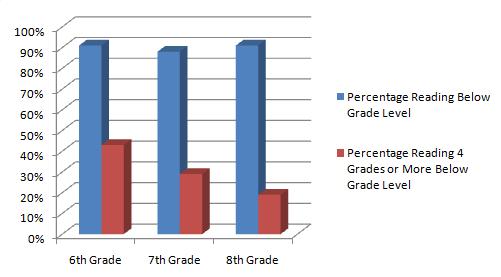_ I thought a good post would be to take you through a normal day here in Pohnpei, detailing the work of the MAHI International Education Team. I then quickly realized that there is no such thing as a “normal” day here. This week was a prime example of the erratic Pohnpei schedule. We’re scheduled to go to our adopted schools on Monday, Tuesday and Thursday, with Wednesday and Friday acting as buffer days for inevitable schedule conflicts. If the schedule holds, my Wednesdays and Fridays are spent tutoring students who are really behind, researching and writing grants, and making the necessary preparations for our time in the schools. I also plan to work at the Department of Education to help assist in policy changes to improve the level of education provided throughout Pohnpei. With that information, let’s get into the week! Monday January 30 On Mondays we travel to Pohnlangas Elementary School, the largest and furthest school in our program. Mr. B and I usually leave Kolonia around 9:00 to arrive in time. I was informed early in the morning though that we wouldn’t be leaving until 10:30 as Mr. B had to attend a funeral. I wrote about funerals shortly after I arrived as a major part of Pohnpeian culture. When talking about the funeral dynamic in Pohnpei to friends and family back home, I often get the initial feedback of “Well, it’s a funeral, someone close to them died, of course it’s a big deal.” While this is true for those close to the individual that passed away, the funerals here are more of a large community event than a traditional American funeral. These funerals put families in debt for years and are a large impediment for progress on the island. How, for example, is a local to invest and start a business, if every time he saves up enough money he needs to spend it all, his entire savings, on a funeral? Mr. B wasn’t close to the person that died, but he is an influential member of his community and high-ranking in the traditional leadership on the island and needed to be there. He picked me up and we drove past the funeral. We were running early and stopped by for me to have the cultural experience of visiting a Pohnpeian funeral. My first reaction was being surprised at how many people were there. I haven’t been in groups larger than 20-30 people during my time here, so it felt very odd to be around 150-200 people. Certainly, I will experience reverse culture shock when I travel home! Beyond all the people, it was impressive to witness the massive amount of resources gathered there. I counted over 20 large Sakau plants (which are very difficult to grow) and over 15 pigs. As I have mentioned, pigs are a sign of wealth in Pohnpei and contributing a pig to a funeral is seen as a major sign of respect. Despite my perceived large size of the funeral, Mr. B said it was an average-small funeral. When a very influential member of the community dies the funerals can get truly massive - imagine 60-70 slaughtered pigs! For this funeral though, seeing all the enormous pigs cut in half and children playing with them was most definitely a unique cultural encounter. 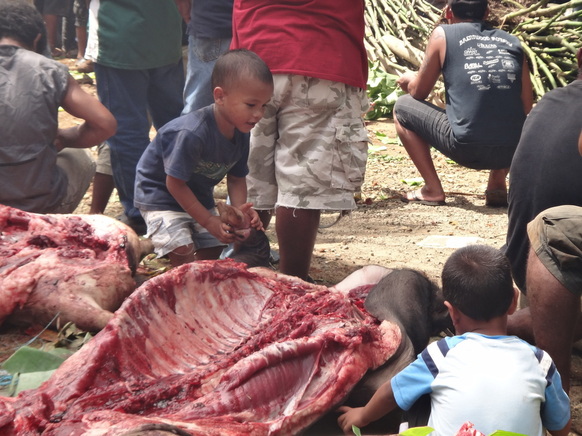 Children playing with a pig at a funeral We continued our drive to Pohnlangas, finishing our 70-minute drive and arriving before lunch was over. We normally teach six classes at Pohnlangas (two for each grade - 6th, 7th and 8th), but combined the classes in each grade to accommodate for our late arrival. I used the Hooked on Phonics program, reviewing the basic letter sounds I previously taught. I then took out the note cards we used to assess all our students during our reading level assessments in October and November. I went through each grade level, correcting mistakes and noting tendencies. I’ll elaborate on my found Pohnpeian tendency in my Tuesday notes (below)! After our three classes, we got back around 4:30 or so and I headed to tutor two children (ages 8 and 11) who recently arrived from Japan. Tuesday January 31 On Tuesdays we work in ESDM Elementary School in the morning and Sapwalap Elementary School in the afternoon. Both of these schools are located in the municipality of Madolenihmw (Med-ole-in-e-um), with ESDM being a 45-minute drive and Sapwalap almost an hour. The normal classroom I use at ESDM was occupied so I had to use the office and adapt to not having a chalkboard. Pen and paper wasn’t as good, but it did the trick. Mr. B and I stopped by a container store on our way to Sapwalap and picked up our normal lunch of nutrition biscuits. They’re nothing amazing, but they get the job done. When we remember/if we have time, we pick up some local food, like below _:  Clockwise: Fried Grouper (a type of reef fish), Rice, Taro, and Mahi (aka Breadfruit) I noticed on Monday in Pohnlangas a specific tendency most Pohnpeians have when speaking English. In fitting with the slow pace of everything on this island, Pohnpeians often speak too slow when pronouncing English words. Two of the most common words in Pohnpeian are spoken ridiculously slow. The word for hello is “Kaselehie” (casa-layyyyyyyyyyy-leeeeeeeee-ahhhhhhhhh). Culturally, the longer it takes to say the more respect you have for the individual(s) you’re addressing. This leads to it sometimes taking literally 5-seconds just to say "hello." The word for thank you is “Kalanghan” (ka-laaaaaaaaaaaaaan-guuun). This slow-speaking tendency translated directly to their speaking of English. When asking the students to say “Certainly” every time they said “sir-taaaaaaaiiinnnnnn-leeee.” Can you see the similarity to “Kalanghan” (ka-laaaaaaaaaaaaaan-guuun)? The students got a kick out of me speaking their Pohnpeian words, but I think they understood how English words are generally spoken more succinctly. Whenever possible, I try to apply whatever I’m teaching to something the students can relate to from what I know about Pohnpei.
Also, I had fun at the schools this week teaching them what "cadence" means. I explained how it's the rhythm in which you speak. I had them drum on tables to understand what rhythm means, and played some rap music (clean rap music, I must note) for them to get an idea of what it means to speak with rhythm and confidence.
Wednesday February 1
It’s February? What? Where did January go? I’m sure I wasn’t the only person that thought this, though being 16 hours ahead of Eastern Standard Time, I likely thought it before you! This week we were still figuring out how I would be using my new-found two “free” days during the week. I spent a large part of the morning researching new ESL teaching methods. I tutored my two Japanese children earlier in the day and spent the rest of the day researching. I expect having a day in the middle of the week away from the schools will be helpful in seeing the greater picture of the issues present in the schools and how we can help. Unrelated to my work was the needed pick-me-up. One of the things I miss most about home is watching sports. As an avid Chris Paul fan, and therefore a new Clippers fan, I likely accounted for at least 20 hits of this epic Blake Griffin dunk:
_ Thursday February 2
On Thursdays we travel to Sekere Elementary School and Sokehs Pah Elementary School (also known as RSP). Both of these schools are in the municipality of Sokehs and are the closest schools, being only 15-20 minutes away. When Mr. B and I arrived at Sekere we found the school completely deserted, save a few kids playing basketball. We asked them if there was school and were informed that there was a teachers meeting all day for all the schools on the island. This is typical Pohnpei - a random teachers meeting in the middle of the week and school being canceled. I guarantee you these students don’t have the US required 180 school days a year. I honestly would be surprised if it was close to 130. We made the plan to do our Sokehs schools the next day.
It really is frustrating to have setbacks like this. I often wonder aloud if we can ever really make an impact in this place, given all the constant obstacles. Despite the frustrations, I took the opportunity to visit the Seventh-Day Adventist School to see my friend Katie, who teaches a student MAHI International mentors. We arranged for me to work with him after school on my two “off” days. I also hoped to obtain more mp3 files the school has on the computer for the rest of the Hooked on Phonics program. The Hooked on Phonics sets that were donated to MAHI International are from 1998 and have the ancient technology of a cassette. I was unable to get the mp3s on Thursday, but made arrangements to get them this coming week. The rest of the day entailed more ESL and grant research and tutoring. Not an expected day, but as you might have gathered, there is no such thing as an “expected” day here.
Friday February 3
I called our Sokehs schools early in the morning to inquire if we could teach that day. I’m told by one principal that many teachers are absent, being sick or attending a funeral. He thought it would be best if we didn’t teach because he wanted the teachers to be there. The other principal said yes (technically, he said "eeeeeeeyyyyy mein" - Pohnpeian for Yes, with the "mein" being for respect, similar to "usted" in Spanish) and we taught there in the afternoon. I spent the morning traveling around with John to various appointments. There are plenty of stories from my time tagging along with John, but I’ll leave those for another time. After teaching in the afternoon I tutored again, where it was nice to evaluate the two children and see their progress from the two weeks I have been working with them.
As you can see, there is no script for a normal Pohnpeian day, or week for that matter. When I woke up Monday I had no idea I would be attending a Pohnpeian funeral, standing in the scorching sun, smelling the sweat of the large group and recently butchered pigs. I didn't plan to use rap music to help teach English, but hey, I needed good examples of cadence in speech! And pulling up to an empty school Thursday wasn't in the game plan. This is just a very small sample among countless examples of a crazy life working on Pohnpei, full of the unexpected. Despite all the obstacles, I love how the days hardly ever blend together. While routine has its benefits, it ultimately makes life go faster – and it’s going fast enough as it is! More than anything, my time here is most definitely teaching me how to adapt and be flexible. Indeed, flexibility is paramount to accomplishing anything on Pohnpei.
So there ya have it. I only have one thing left to say: GO GIANTS!!!
 __ The world has 6.8 billion people. Pohnpei, a tiny island in the middle of the Pacific Ocean, has a population just under 36,000. I’m willing to bet a large sum that the vast majority of you probably first heard of Pohnpei through my coming here. I know this because out of the probably over 100 people I talked to about my plans to serve here, only one person had ever heard of Micronesia. Indeed, in the world of current affairs, Pohnpei and Micronesia are not at the top of the Google search. When discussing how to fundraise and effectively solicit funding for our various projects, one of the main questions I have proposed is how do we get people to care about this tiny island? There are many possible answers to that question. The first that comes to mind is obvious - “these are people too – why should they receive any less attention or resources just because they live on a small island?” This is perhaps the best answer. When it comes to our education projects however, I have a special answer to why Pohnpei matters. In the developing world there is an overwhelming lack of educational resources. Only the extraordinary students will flourish and have a chance to further their education at the collegiate level or beyond. Throughout Micronesia however, this is not the case. Thanks to the US government, students here have the same privileges found on Native American reservations – access to a free education through the graduate level. This isn't written anywhere, but the number of scholarships available is immense, to not just the exceptional students, but the average and below-par as well. There are not many places in the world where the youth have this much access to a free college and graduate school education. The tragedy though is the amazing opportunities available to these students are regularly wasted. When students do take advantage of these scholarships and go to college, they often face so much remedial education that they drop out after a semester or flounder and go to school for six years before their funding runs dry. Of course there are exceptions to this, but this is the general trend. If these students managed to catch up with their reading proficiency, developed an intellectual curiosity, and pursued further education, the sky truly is the limit. It all starts though with bringing these kids up to speed so they are reading at or above grade level. We have a program in place that will make a difference in the lives of these students. The entire MAHI team has a sense of urgency that is palpable. It’s exciting to be part of this movement to help improve the education system here on Pohnpei. This is all a very, very slow process, but we are in this for the long haul. Would you like to join the movement? MAHI International is supported solely by generous individuals. Click here to learn how to make a gift! There's nothing much worse than wasted talent and opportunity. If we follow the status quo, nothing will change and this failed system will continue to produce students unprepared to continue their education. With support, we can buck this trend and change lives, generating students with an extremely bright future taking advantage of all the opportunities presented before them. I recognize my last few posts have focused on education - I promise my next post will be focused on my interactions with the culture and my experiences in and around Pohnpei!
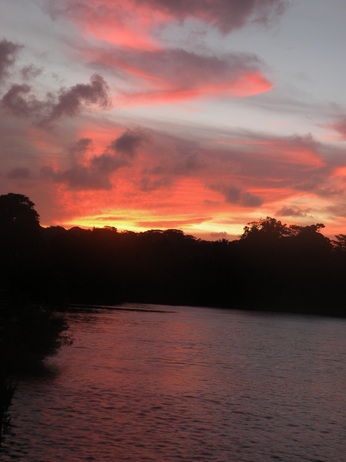 Recent sunset on the outskirts of Kolonia
 John introducing the dictionaries In the public eye, there is a clear distinction between non-profit organizations – faith-based or secular. The former engage in proselytizing activities while the latter focus on providing basic human services or raising awareness for a cause. Often however, the distinction is not so black and white. MAHI International is one of the organizations that falls in the gray area. Described as a “Christian-driven” organization, MAHI focuses on providing for the needs of the islanders, in areas such as healthcare, education and energy. From a personal perspective, I believe sharing the Gospel is one of the most valuable services you can provide. In the same breath, I believe it’s possible to live out the Gospel by helping others in different ways. MAHI has done this by donating beds to a hospital, working to improve literacy in the schools, and installing solar panels on outer islands, just to name a few. This reflects one of my favorite quotes from St. Francis of Assisi: “Preach the Gospel at all times and when necessary use words.” This past Wednesday, the MAHI team assisted in the delivery of new dictionaries donated by the Rotary Club to all 8th graders on Pohnpei, visiting over 15 schools. Many of the kids were absolutely stoked to receive their early Christmas present. In one school, the teacher told all her students on Monday that they needed to have a dictionary by Friday. We asked how many had purchased one yet – we saw no hands. Shortly thereafter, the teacher said we were “sent from above!” That wasn’t the first time I have heard such a comment. Indeed, as a Christian-driven organization fulfilling secular needs, I always smile when I’m reminded that we are doing God’s work. While it would be great to hand out Bibles, the majority of these students are reading three grades or more below grade level, as found by our student reading level assessments. Mind you, that assessment was only testing if the student could read the words – comprehension wasn’t even a factor. Distributing dictionaries won’t educate these students and send them to college, just like handing out Bibles won’t immediately lead to spiritual revival. Both are only mere steps in a long journey. I went to college in a campus that can fairly be defined as liberal, like most college campuses. Every year the Gideons came to town and handed out free pocket Bibles. I was always excited to receive a free Bible, but was disappointed to see other students take the Bible and throw them out, or openly ridicule the people distributing them. While in theory handing out “the good Word” is never a bad thing, it was obvious that it was going to take a lot more than handing out a book to convert anyone that day. Similarly, we have a lot more work on our hands to combat illiteracy on Pohnpei than just handing out dictionaries. There is no silver-bullet solution, but these dictionaries are another tool in our arsenal. We are moving forward in our education program, working out logistics regarding our community night with all the schools, where we plan to present all our results and galvanize support for education among the parents and community leaders. The Christmas spirit is in the air, which is weird for me given it's over 80 degrees every day!
 With all the 8th Graders at Pohnlangas Elementary School 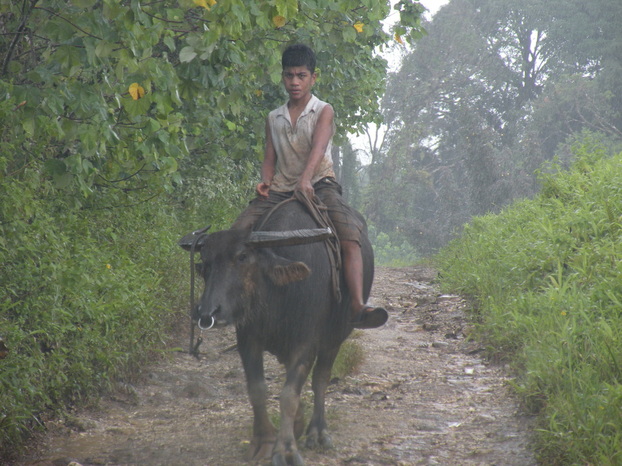 A little roadblock on the road to Salapwuk Elementary School
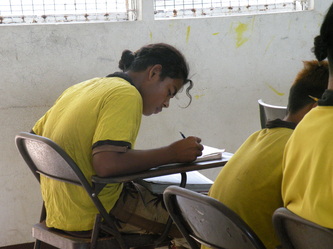 A student working at Sekere School The answer for every single issue in our world is simple: education. That might seem like a broad statement, but try to think of a problem that can’t be solved by an educated citizenry. Most issues are extremely complex and it is foolish to seek a silver bullet solution. However, it is imperative we recognize how crucial it is that the children of today know how to think critically and express their beliefs and opinions through oral and written mediums. The future will be built upon science, math and engineering, while we will progress through our ability to read and write. Education opens up a world of possibility if only we hold high standards and recognize our limitless potential. I am not familiar with any statistical study proving this, but I believe that the area most critical to the success of a school or education as a whole in a selected area, is the presence or absence of a culture of achievement. If the standards are high at all levels – government administration, school officials, teachers, parents, community leaders and students – success is inevitable. Again, that might seem broad or simplistic, but after spending four years in an environment with high intellectual standards, it’s hard to ignore the lack of such standards here in Pohnpei. I want to be crystal clear on one thing – these students, including the ones who are extremely behind, are not dumb. They are very industrious, creative and downright tough (I have yet to see a Pohnpeian kid cry, despite witnessing some nasty falls). They are simply the products of a failed system. The institutions and traditions that make up this system are deeply entrenched and steeped in a culture of ambivalence. Working within this system has been a challenge to say the least. God is no doubt teaching me the importance of patience (over and over and over). Despite any frustrations, I have enjoyed working with the kids conducting the student reading level assessments. Many times after finishing the assessment I would encourage the student to read more, adding “Knowledge is power!” It might be a bit corny, but it’s true! When I say “knowledge,” I’m not referring to knowing dates wars started and what an old white guy said (though as a history buff, those are good things to know!). For these kids, “knowledge” is reading proficiency. Here’s how it goes for far too many Pohnpeian students: - Enter high school 3-4 years behind in their reading level
- Get pushed through high school, being lucky if reading at an 8th grade level at graduation
- Enter COM (College of Micronesia) if pass entrance exam
- Face far too much remedial education at COM, become discouraged and drop out after less than a year
Of course this isn’t the course of events for every Pohnpeian, but it is certainly a notable trend. If these kids enter high school 3-4 years behind, unless they are lucky enough to run into an amazing teacher somewhere, they are on a track for failure. Here’s the problem. Now we’re going to do something about it. We visited all the principals of our adopted schools this week presenting them our report which included our recommendations derived from our teacher and principal evaluations and the results from our student reading level assessments. The principals were especially excited to get each student’s reading level. Now that they know what level each student is reading they can work with each student appropriately, giving him or her the proper amount of attention and assigning the proper resources. Indeed, knowledge is power. (Side note: I’m planning on posting on the blog once a week, on Thursday or Friday – so to most of you who read this, on Wednesday or Thursday. Occasionally I’ll post more often, and I might be delayed in posting if the Internet goes down like it did for a while this week. Just an FYI.)
 A quote from Dr. Benjamin Rush, founder of Dickinson College, on the wall in the Dickinson Admissions Building
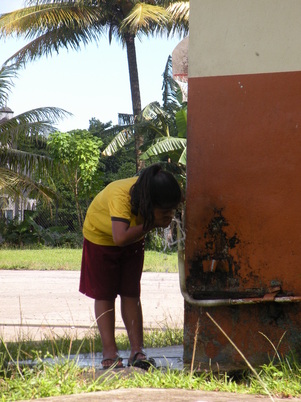 A Pohnpeian Water Fountain After much contemplation, research and analysis we finally have a plan that I am confident will make a major difference in helping the schools we have adopted. I have already posted the results from our time in these schools in case you were curious of their current status. Our plan consists of the following three-prong approach, with the initial goal and how we intend to accomplish each goal: Create a collaborative community and school partnership- Hold a community night at each school, inviting students, parents, teachers, administrators, and traditional leaders of the community. The focus will be on the importance of education for the future of each child, the community, Pohnpei, and the world.
- Work with each school’s PTA, introducing new strategies for parents to support and encourage their children’s education.
Strengthen leadership at the administrative level- Encourage and support school principals by having one-on-one appointments with the principal and Mr. Miller Benjamin, MAHI International’s Senior Educator. These meetings will occur on a five-week rotating schedule, with Mr. Benjamin meeting with one principal a week.
- Hold a second principal workshop in January with the five principals of the schools we have adopted.
Teach English and introduce new strategies to the teachers- Use tablet computers installed with English learning software to improve each student’s reading level. We will be visiting one school a day (a school for each day of the week) and teaching in grades 6, 7 and 8 for one period. This will consist of a 20-minute lesson from the MAHI International Education team, followed by 30 minutes of the students working on the tablets, completing work related to the lesson for the day. The teachers will also complete this lesson so they can become familiar with the teaching strategies presented in the tablets software.
- Hold a two-hour workshop once a week with all the teachers at the school. This will occur on a five-week rotating schedule. Each workshop will focus on a specific topic that is integral to successful teaching (ex. lesson planning, classroom management, etc.)
This is the basic outline of our plan, as each step obviously involves more details. So how did we get to this plan might you ask? Well let me start with the first two parts, creating a collaborative community and school partnership and strengthening leadership at the administrative level. I stumbled across a few pamphlets called the “Micronesian Counselor” published by MicSem and authored by Francis X. Hezel, SJ, who has been serving in Micronesia for decades. I read Hezel’s conclusion that throughout his years of observation, the only schools that are successful are ones who have community support and strong leadership at the principal level. My past experience speaks to this, when I interned at the White House Center for Faith-Based and Neighborhood Partnerships at the US Department of Education, whose chief goal is to stress the importance of community support in education. I traveled across the country and witnessed firsthand how critical community support is for a school to be successful, and how difficult it is to cultivate this relationship. Reflecting on my own brief couple of months in the Pohnpei schools, I couldn’t help but agree with Hazel. There are many obstacles in the way of achieving these two goals of which are the most absolute necessity to achieve any sort of success, but I believe we are at a great advantage knowing what is most important to produce any sort of long-lasting change. The last part of our approach, teaching English and introducing new strategies to the teachers, took a lot of deep thought. In case I haven’t made it clear, English is the second language to every child in these schools as they are first introduced to their native tongue of Pohnpeian. The vast majority of their teachers have graduated from the College of Micronesia with an AA degree, where all classes are taught in English. Despite obtaining their degree, many of the teachers are not comfortable with their English skills. I witnessed several teachers teaching English lessons incorrectly. Simply put, many teachers are just not qualified to teach English. Mr. B was the principal of the local SDA School here for the past 19 years. He oversaw its rapid growth, almost doubling in size and becoming one of the best schools on the island. I asked Mr. B why the SDA school was so much more successful than the public schools. While there are many possible answers to that question, his immediate response was because they were being taught by native English speakers. The majority of the SDA teaching staff is composed of SMs (Student Missionaries), most of whom are taking a gap year in college to teach here in Pohnpei. Ideally, we want to bring volunteers to all the public schools, whether from Peace Corp, World Teach, or through MAHI like myself. While there are many of these teachers throughout the island doing great work, there simply are not enough. Our solution: tablets. We are in the process of obtaining tablet computers installed with English learning software. Most of these students have never worked with a computer before. There are countless studies which demonstrate the positive effect technology can have in the classroom, particularly with tablet computers and especially in developing countries. If this technology is used appropriately, it is virtually guaranteed that students will make tremendous gains. Besides the new medium the tablets offer, I also believe we will be successful by who we are bringing into the classroom. Mr. B is an extremely experienced educator and a respected voice throughout Pohnpei. Over the course of all our evaluations and assessments all he could talk about was teaching; he clearly wants to just get back in the classroom and teach. Indeed, the first time I met him, only a day after stepping off the plane, he informed me that we were going to go teach the next day. Fortunately there was a scheduling conflict so my jet-lagged self could get some sleep! I’m really excited to see Mr. B back in his element, doing what he does best. Whenever Mr. B needs a break, I’m sure I will get the opportunity to teach as well. I have no illusions of being even in the same ballpark as Mr. B when it comes to teaching, but I’m looking forward to giving it my best shot. The reason I’m most interested to try is this – I’m a menwie (i.e. a foreigner, a white guy). Every time I visited the schools I was always looked at like I was an alien creature. Normally if you are caught staring at someone in the States you look away immediately, hoping that your staring subject didn’t see you. Here, they just continue to gaze. I just smile and say “Lelie!” (lay-lee-ah), i.e. Hello! I have no idea what to expect when I first try teaching, but I already have their attention, so I’m off to a good start! I’m sure with Mr. B’s tutelage I’ll be at least a somewhat competent teacher. So there ya have it – there’s our brilliant game plan for reform. Any thoughts? Suggestions? E-mail me! I would love to hear any feedback. You will surely hear more about how this plan is going, and how ultimately, true change cannot be imposed on the Pohnpeians - it has to come from within. I hope our program won't be an unwanted demand from an outsider, but rather a nudge in the right direction. Much more on this in future posts. Also want to wish a Happy Thanksgiving to everyone! It might not be Thanksgiving yet for you, but I’m 16 hours ahead of Eastern Standard Time! Surprisingly, Pohnpei doesn’t celebrate Thanksgiving despite celebrating virtually every other holiday known to man. Don’t worry, they celebrate Harvest Day on Friday (refer to my last post to see the ridiculousness in that!). For our latest adventure, Dale, John and I climbed to the top of Sokehs Rock (that big rock you see in the banner picture at the top of the screen). Despite some relatively sketchy parts, where a false step will lead to your ultimate demise, we made it out alive. I'm looking forward towards camping at the top eventually - the sunset and sunrise should be truly epic.
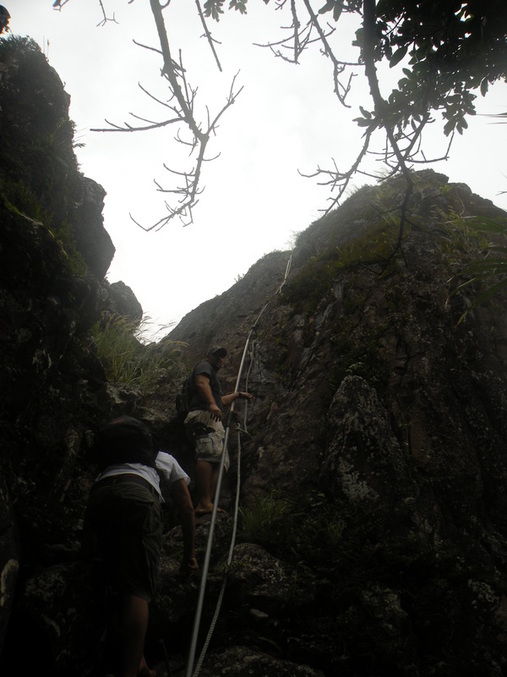 The climb up. Very thankful for the rope. 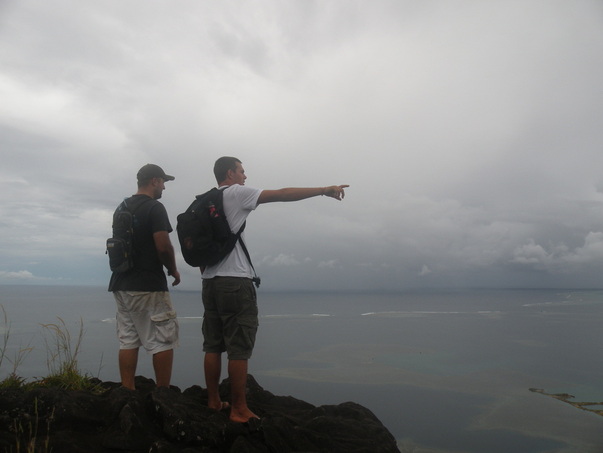 Pointing out atolls we have visited 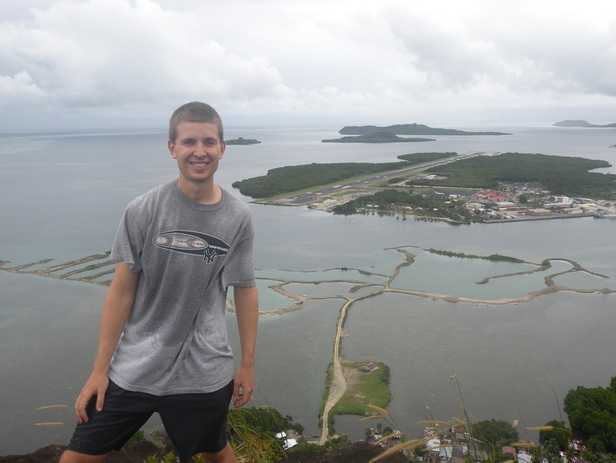 Was a pretty cloudy day so the visibility was poor. Can still make out the airport though!
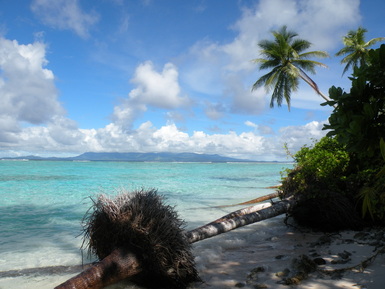 A view of Pohnpei from Ahnd Atoll I was introduced to an interesting theory this week regarding the slow pace of life in Pacific island communities. The theory states that there is a lack of urgency that pervades the culture in climates without winter, as people never have to prepare ahead for anything. Pohnpei would certainly fall into the category of being “winterless” as the daily low and high temperature for the day never vary by more than five degrees all year. Never does a Pohnpeian have to worry about being snowed in after a big storm, or plan when they want to plant and harvest their crops – every day is like the last and tomorrow will be the same. While I had read plenty about “island time” before I arrived in Pohnpei, the slow pace hasn’t really struck me until lately. Perhaps it has just been a bad week, but I have been particularly frustrated by how long everything takes. Take a normal meeting for example. A meeting that should take five to ten minutes often takes 30 minutes to an hour. People drive very slowly as well. The island speed limit is 25mph, but it’s rare to go more than a mile without someone driving between 5-10mph. Beyond just daily inconveniences there is no sense of urgency to solve any of the pressing issues present on the island. From healthcare to infrastructure, energy to education, every problem can be solved "lakkup" (i.e. tomorrow). Of course this is a generalization, but on the whole this is the culture of Pohnpei, and from what I’ve heard, all Pacific island communities. Given all of this it’s interesting to think that Pohnpeians, Micronesians, and all Pacific island communities have a lifestyle that is directly impacted by the weather. For those that don’t know, I come from a family that loves snow. No matter what the season, snowmen decorate the house. My brother still recalls the Blizzard of ’96 with childhood wonder and my father can cite snowfall records from the past century by memory. Indeed, he is legitimately a “snow expert” specializing in global snow cover. They were quite confused when I decided to live somewhere for a year where it has never snowed – ever. But I’m sure they would be overjoyed to hear that according to this one theory, which I believe holds some legitimacy, the world’s prosperity and development owes its existence to snow. As always, we have been very busy with our education program. We have a very exciting plan in store that I look forward to sharing within the next week or so. It has been a challenge to comprehensively address the great number of issues we found in the schools, but I am confident our plan will make a great difference for these students. This past weekend was a lot of fun camping on Ahnd (pronounced “Ant”). Check out some pictures of the island beauty and fishing heaven.
 My favorite shot from the weekend: a fallen palm tree being lapped by waves at dusk.
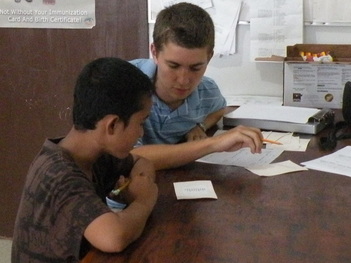 Conducting student reading assessments at Sapwalap Elementary School We have quite a challenge ahead of us.
Attached are the student reading level results with accompanying statistics.
It has taken quite some time to get all this data, but it is imperative that we know where we are before we start with our program. Tomorrow is Veterans Day, and Micronesians celebrate pretty much every holiday known to man, so we will get started next week. A bunch of us are headed to the outer island of Ant to go camping for the weekend. It will be difficult to get my head away from the large task in front of us, but a change of scenery is welcomed.
Despite the immensity of the challenge facing us, I know that our mission is crucial. The students here have more educational opportunities than most people in the world. The number of scholarships available to them are vast, if only they are equipped with the tools to achieve. Essentially, a motivated and diligent student in Micronesia can be educated through the graduate level for free. However, the average Micronesian student has many more challenges than their American counterparts.
Change will not happen overnight, but knowing how important our work is will certainly drive the entire MAHI team to persist throughout this great and worthy undertaking.
Pray for us!
 6th Grade Reading Level from one of our adopted schools (P=Primary, i.e. Kindergarten; PP=Pre-Primary) - Assessed 560 students in seven schools
- Average student is reading three grades below grade level
- 37 students are reading at Kindergarten level or below
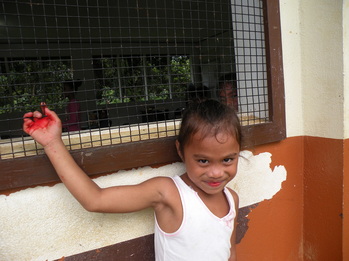 We are out of the classrooms this week as the schools have Monday and Friday off and Finals Tuesday-Thursday. We are taking this time to compile all our data collected in the schools so far and plan how we will attempt to reform the problems we have confronted. I thought I could take this break from reports in schools to write about nutrition here in Pohnpei. It’s no secret that the average Pohnpeian does not keep a healthy diet. Prior to colonization, they were subsistence farmers, eating a diet of fish, taro, bananas and other local food. With the drastic change in lifestyle has come a drastic change in diet. While there is still an abundance of fresh local food, the islanders taste buds now prefer ramen noodles, soda, Kool Aid, canned meats and turkey tail (which has 13x more fat than the rest of the turkey). As a result of these diet choices, Pohnpei and the other three states in the FSM have some of the highest rates of diabetes per capita in the world. It is not unusual to see individuals with limbs amputated from the disease.
One of the biggest issues is the lack of basic health education. MAHI has made efforts to bring this education to the islanders but obviously it is an uphill battle. I think the best way to paint the picture of the severity of the situation is a few scenes I have witnessed. On our first site visit, I saw the girl in the attached picture, licking her hands. Her hands were bright red, but it clearly wasn’t blood as it looked like some sort of powder. I asked John and he told me it was Kool Aid mix. Since that first girl I have seen countless kids walking around licking their hands. A common lunch is dry ramen mixed with Kool Aid. I have been told that kids die every year from renal failure as a result of this diet.
Another scene occurred when I picked up Mr. B the other day. A girl about ten-years old was walking to school drinking a can of soda. Apparently soda is a common breakfast. Perhaps the most shocking scene though was a parent giving her baby a lollipop to suck on instead of a pacifier. While this might invoke outrage, I don’t get the impression that this harm is done intentionally. I truly believe that many of the islanders, particularly the parents feeding their children, don’t know the negative effects of this diet, or at least the severity of the consequences. Compounding this diet is the lack of other basic health knowledge such as the importance of brushing your teeth and regular exercise.
It’s easy to look at the current problems and blame the islanders for their lack of knowledge. But if you look at the history, it’s difficult to blame anyone besides the United States. Prior to the US occupation of Micronesia, the islands were colonized by Spain, Germany and Japan. It wasn’t until the US flooded these islands with sweets that these problems emerged. After studying and spending some time on the Navajo reservation in Arizona, it is clear that Micronesians and Native Americans face many of the same issues. Ultimately, what they share in common is the curse of government handouts. This deserves another post or two, but I feel it is appropriate to put the complex issue of nutrition here in Pohnpei and throughout the FSM in the proper context.
One of the most common questions I received prior to arriving in Pohnpei and since is what I eat. I’m going to hold you in suspense until my next post, which includes video of me sampling a local delicacy…
For now, check out the videos below of some jumps off the Lehn Paipohn Waterfall this past weekend. Sorry mom!
 The vast majority of my time spent here in Pohnpei is going to be focused on improving the education system. I will be working closely with Mr. Miller Benjamin, MAHI’s Senior Educator. Mr. B has over 30 years of education experience on the island, after recently retiring as Principal from the SDA School here. His knowledge of the culture and education in Pohnpei will be invaluable on our mission. I am extremely excited to work with him. On Wednesday, John, Mr. B and I visited the seven lowest performing public schools on Pohnpei. Our eyes were opened to many of the problems we are going to face over the coming school year. There are many different areas we can focus our efforts, but we have decided to concentrate on reading and writing. We have learned through several teachers and following our intuition, that students cannot learn mathematics, science, or any other subject, unless they can read and write on grade level. Perhaps the biggest obstacle to getting students to read on grade level is when they start learning in English. In Grades 1-3 students are taught in Pohnpeian. What we found is that every grades curriculum is three years behind, so that a Grade 8 student is reading on a Grade 5 level. The situation is more severe than this however. When students start learning in English in Grade 4 it is not an instantaneous shift. Questions and explanations are still in Pohnpeian and it is not until Grade 6 or so at best when English is the primary language heard in the classroom. We will be conducting assessments to see exactly at what level the students are reading. I am fairly confident the majority of students will be at a minimum of 3-4 years behind. The obvious solution is to start teaching students in English beginning in First Grade but many in the Department of Education are opposed to such a policy change as they fear the loss of culture in the youth speaking their native language. Although their sentiments are understandable, the fact of the matter is that the policy is causing the students to fall behind for the rest of their education. While Pohnpeian is a beautiful language, it would undeniably be to the youth’s advantage for them to start learning in English at the start of their education. Pohnpeian is only spoken on this island, and their ability to read, write and think in English is critical to their future success and prosperity. Beyond the policy decision to delay learning in English, there are many other problems in the education system in Pohnpei. In many of the schools we visited, they were lacking in basic supplies, particularly textbooks. We found textbooks from the 1980s and many schools without enough books. Another key educational resource was also missing – teachers and administrators. Every other week the principals of all the schools are gone for a whole day attending meetings in Kolonia. Apparently, meetings in all sectors of government are very popular in Pohnpei. Also, several teachers were not present as they were attending workshops. Why they don’t have these meetings and workshops in the summer is beyond me. Several times, I had to step back and wonder where to even start in tackling these problems. While these site visits were very informative, we still have much to learn about these schools. We will be conducting assessments of the teachers and the teachers will be assessing themselves and their administrator(s). After this we will be conducting student reading assessments to find their reading level. Before we can help them, we have to know where they are, assessing the “damage” in a sense. Moreover, in assessing the teachers and administrators, we will have a better idea of the organizational integrity of the school and how to best assist and instruct them. I only touched the tip of the iceberg with the problems facing us in our efforts to raise the reading and writing levels at the seven schools we have adopted, but this is a cursory glance of what the main issues are from our first impression. Ideally, we will be able to dramatically improve the level of teaching and administration at these schools, thus increasing the level of reading and writing at all grade levels. Furthermore, this would be a sustainable program, as the teachers would remain in the schools year after year to continue being successful teachers. The educational world is in agreement that the most valuable education resource is the teacher. If we can produce great teachers on Pohnpei, we will have taken the largest and most critical step in providing the youth of Pohnpei with a quality education. These seven schools are only a trial run – hopefully we can expand it to all 35 public schools on the island. My ultimate dream for these schools, and for all of Pohnpei, is for a culture of achievement to spread throughout the island, originating in the schools from students seeking to fulfill their infinite potential by pursuing their education. I have no illusions that this dream will be easy and without obstacles. Indeed, it will be a long, arduous venture that will likely extend beyond my time here. But as Lao-Tzu famously said, “Even the longest journey begins with a single step.” Click here to see pictures from the site visits!
 Photo courtesy MAHI International Today was an interesting day, visiting many of the places I will be working in Kolonia and meeting people I will be collaborating with on various education projects. Throughout this time I took advantage of the opportunity to pick John’s brain particularly about work culture in Pohnpei and the many obstacles he has confronted during his eleven years so far on the island. What will stick out in my mind about today though is our visit to the Pohnpei State Hospital. The education initiative of MAHI is actually a recent development, as the majority of their work has focused on basic human services including healthcare. A large 40-foot container organized by John in the States is scheduled to arrive in about a month filled with hospital beds, bassinets, exam tables and many other medical supplies for the hospital. MAHI has also worked on construction projects in the hospital, such as recently converting storage rooms into private rooms for patients. While MAHI’s past work in the hospital has been very helpful, the current state of the facilities is simply shocking. On the whole, the building looks like it hasn’t been touched since the 1940s. Rust coats many of the metal instruments. Ants cover many areas of the floor. Less than twenty yards from the ER ward, the ceiling was rotting away and dripping from a leak in some area of the buildings structure. All in all, the entire building was just dirty; even the sign in front is covered in rust. More than just the building itself, the hospital is lacking basic supplies. None of the beds have any sheets on them since previously they disappeared when patients were discharged. John told me that much of the hospital is without soap as, like the sheets, employees and patients took the soap home. (I will have a separate post in the future about the Pohnpeian tendency to have supplies, such as school textbooks, disappear never to be seen again). Perhaps someday I will post pictures of what I saw today, but I really don’t think pictures will do the scene justice. Vast improvements are needed but like in most of the world, change is really hard. Indeed, I’m sure I will experience many frustrations with the lack of progress, or at least the speed of any progress, during my time in Pohnpei. The phrase often used is “island time.” To get anything done, whether trying to get information from a government agency, get Internet expanded in your home, or even pay for an item at a store –takes forever. A great example is John trying to get power to the house he built. It literally took three years and that only happened with a stroke of luck and a lot of perseverance. Despite the awful state of the hospital and the often stagnant to slow pace of progress, it is encouraging that progress is possible through organizations like MAHI International. When there are people on the ground like John, Kat and all those who support MAHI whether through volunteering their time or resources, change is not only possible, it’s inevitable. This change isn’t fast or easy, but after seeing how driven the MAHI team is and how much of a heart they have for service; it’s clearly evident that no obstacle is insurmountable. I hope I can cultivate such a passion during my time here and I am excited to help improve the education system, ready to tackle all the obstacles undeniably waiting for me.
|
















